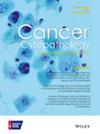Amyloid, presenting as a mass, is termed amyloidoma. Among the reported cases, fine-needle aspiration (FNA) of amyloid is often misinterpreted as acellular nondiagnostic material.
A computer search of all FNAs was performed and cases diagnosed as amyloidoma were identified.
Among 11,956 cases and 20,634 FNAs, there were six cases and 12 FNAs of amyloidoma. One case with mucin/myxoid matrix was misinterpreted as amyloid, which on our review was Congo red negative. All five other cases of amyloidoma were adequate for evaluation. The smears showed most of the aspirated contents in the middle of the slide and it did not spread when smeared. The amyloid was present as large chunks of waxy, smooth, orangophilic/cyanophilic fragments on Papanicolaou stain and as basophilic fragments on Diff-Quik stain in a clean background. In cases with lymphoma/myeloma, there were admixed lymphocytes and/or plasma cells. Unlike fibrous tissue, amyloid aspirates well and provides adequate material for interpretation. The clean background distinguishes it from mucin/myxoid matrix. Congo red stain was positive with apple green birefringence in all five cases. Further subtyping by mass spectrometry showed AL (κ) type in three patients and AIns (insulin) type in one patient. In one patient with lymphoma, the subtyping was not done.
FNA of amyloidoma is rare (0.04%), but an optimal method for diagnosis and subtyping, avoiding unwanted surgical interventions. Although mistaken for fibrous tissue, which aspirates poorly, abundant acellular orangophilic/cyanophilic material on FNA should raise a suspicion for amyloid. Unlike mucin/myxoid matrix, amyloid does not smear the background.


